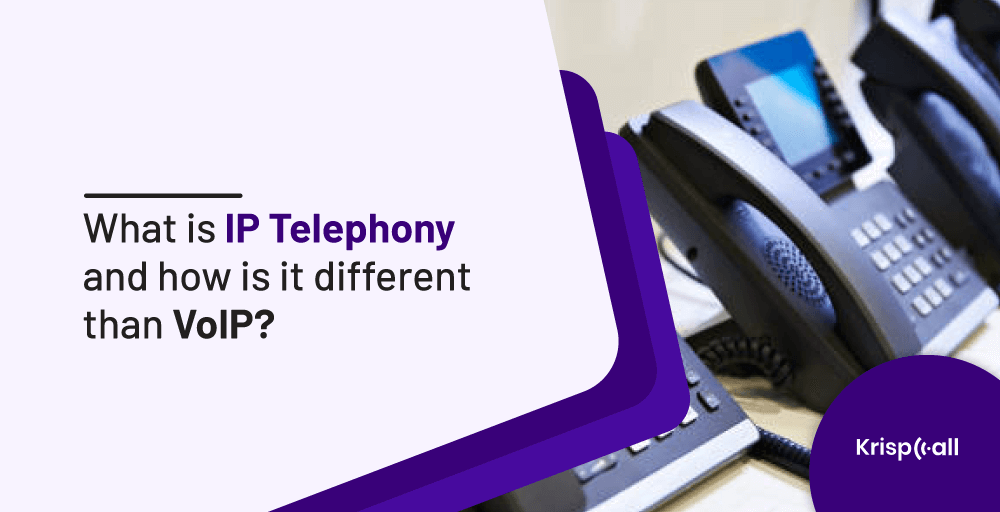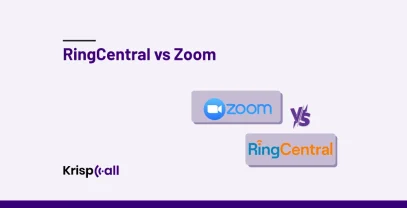Telecommunications technology is rapidly evolving. However, the introduction of IP Telephony was one of the most significant changes in the evolution of telephony.
At a time when ISDN (Integrated Services Digital Network) lines are set to expire in 2025, it’s time to learn more about IP Telephony: what it is and how it can assist your company in the transition to the digital age.
Sometimes voice over internet protocol (VoIP) and IP telephony (IP) are used interchangeably. But in reality, VoIP is merely a subset of IP Telephony. The distinction between the two names is so minor that most people think they imply the same thing.
Let’s have a closer look at what IP telephony is and how it is different from VoIP.
What is IP telephony: how does it work?
IP Telephony (Internet Protocol telephony) is a communication term for products, services, and technologies that use the IP packet for switching connections to send and receive voice mail & automated voice messages, faxes, video conferencing, instant messaging, and other types of data over IP-based networks.
These systems often integrate a Voice API to enable developers to create and manage voice applications within the IP telephony framework. It is, in reality, the technology-specific word that satisfies today’s smart communication requirements.
IP telephony works by transforming phone conversations, faxes, and text messages into data packets that flow across computer network lines bypassing PSTN fees.
IP telephone systems use the Internet Protocol (IP) or other digital protocols to transmit voice communications over the Internet. When using an IP PBX system, data is exchanged digitally over a LAN, converted to analog voice signals, and sent to the PSTN.
What is VoIP, and how does it work?
The abbreviation for VoIP is Voice over Internet Protocol, a well-established technology that allows anyone to make phone calls over the Internet. With broadband development, VoIP has become the clear alternative for consumers and businesses alike for phone service.
People prefer VoIP phone service to regular phone lines since it provides far more features than analog phones. VoIP allows you to handle an unlimited number of calls at a low cost.
A VoIP is a phone system that uses your internet connection rather than a traditional landline or mobile network to make phone calls. A VoIP system works by converting analog speech impulses into digital signals using your internet connection. Calls are connected to numerous telephone networks via a VoIP server.
You can use VoIP as long as you have a high-speed internet connection, as well as a router and modem. Because VoIP is conducted over the Internet, your data is safe in the cloud. An online dashboard allows you to administer the VoIP system.
IP Telephony Vs VoIP: How is IP telephony different from VoIP?
Even inside the field, the words VoIP and IP Telephony are frequently used interchangeably and even as synonyms for one another. The sole difference is that VoIP refers to Voice over Internet Protocol (VoIP), whereas IP Telephony can refer to any communication, including voice, fax, SMS, voice messaging, etc.
Businesses are replacing traditional phone systems in their offices with “IP telephony,” also known as an IP PBX, which uses the Internet Protocol. IP technology is used within a private data network in a single place or over a private network to reach faraway locations with IP telephony.
Using the public Internet to conduct voice traffic is referred to as “VoIP.” Because you don’t have as much direct control over the quality of service while using the public internet as you have when using your network, speech quality over the Internet is more likely to decrease. Voice quality via the public Internet, on the other hand, can rival that of traditional phone lines if correctly constructed.
In recent years, though, even VoIP providers and telecommunications companies have started to use these terms interchangeably. IP telephony and VoIP cover phone systems that use a LAN (local area network) to connect to the internet via a modem/router.
Features of IP Telephony
1. Handover of the call
Call Handoff is a function that allows users to seamlessly transfer calls from one device to another (for example, calls from a desktop (softphone) to a mobile phone, a desk phone to a mobile phone, or a mobile phone to a conference phone). All of this switching occurs in the background, so the caller is never aware of it.
2. LCR (Least Call Routing)
This cost-cutting feature determines the optimal way to route calls automatically (as network providers have different pricing models for calls to mobile radio networks for long-distance and international connections). It ensures that the least-cost routing path is selected for each external call connection and that the call is routed properly.
3. Screening of phone calls
The call screening tool allows you to customize how you screen incoming calls and choose the best option (Find me, Transfer, Forward, Send the call to voicemail, Hang up)
4. Find and follow
This function is designed for business workers who are frequently out of the office but need to connect. It dials the user’s phone number from a list of numbers till the call is answered and the call is not pushed to voicemail.
So, for example, the system may be set up so that your office phone rings twice, but your cell phone rings on the third and fourth rings, and your home phone rings on the fifth, and if the list is completed, the call is forwarded to voicemail.
Benefits of IP (Internet Protocol) Telephony
Explore why you should adopt this modern platform, including its scalability, cost savings, and flexibility to access it anywhere.
1. Reduced costs
When you call on a standard phone line, your phone provider costs you for each minute of call time. When it comes to enterprises, this adds up quickly because hundreds, if not thousands, of phone calls, are made every day. Unless the customer has an unlimited plan, most cellular phone monthly plans come with a set number of minutes.
If a person uses more minutes than they have, they will be charged extra the next month. If you have a prepaid phone plan, you must add more minutes before your current plan expires. However, with an IP address, the internet service provider is the only monthly price.
2. Scalability
Landline users must pay for each phone line and the amount of time each employee spends on an outgoing call; the number of phone lines they can afford is sometimes limited.
There are no such limitations with IP phone systems. All call routing is done in the cloud, and IP is wireless. If a company needs to add another phone line, they have to plug in an IP phone to their router, and they won’t have to pay for another phone line.
On the other hand, IP is extremely portable, and calls can be handled by a remote worker on the opposite side of the country or even the world.
3. Remote Access from Anywhere in the World
As the demand for a remote workforce grows, IP communications can enable your employees, customers, and suppliers to stay connected no matter where they are.
Calls are routed to any online device because the technology leverages the Internet. Because voice calls are now genuinely mobile, your staff don’t need to be confined to one location. As you transfer your employees away from physical locations and towards a digital workspace, this could have a cost impact.
4. Simple to implement
IP phone services are simple to incorporate into an organization’s existing infrastructure. Faxes can be transmitted over email using IP phone services and deliver credit card data faster via the network; the workforce’s productivity will skyrocket, improving customer service by allowing information to be retrieved, transferred, and received more quickly.
What are the Challenges of IP telephony?
Since voice IP packets are regarded the same as any other data, they are prone to delays, loss, and retransmissions, especially when the network is overloaded. Losing every other syllable of the phone call can render the call essentially useless. IP telephony has the following challenges:
1. Overloading the router
A router prioritizes network data processing, and it may reject speech data packets while downloading images if it is not configured properly. Your VoIP call quality will degrade as a result of this. However, if Quality of Service Prioritization is enabled, the router will prioritize VoIP packets.
2. Loss of packets
A data packet containing a chunk of the voice audio is sometimes dropped entirely, or several are dropped in rapid succession. Packet loss is caused by jitter, misconfiguration, data rate restrictions, or a firewall that has been instructed to deny data from a certain source.
3. Latency
When using IP telephony, you may have noticed a delay in the dialogue, known as latency, which occurs when the Internet can no longer manage the amount of data streaming through it. Increase bandwidth by upgrading to a faster internet connection that can handle more data flowing simultaneously.
4. Jitter
Latency is linked to jitter. It’s the rate at which latency rises and falls, causing data flow to be disrupted.
Jitter occurs when voice audio is fragmented into thousands of tiny packets, resulting in some sounds coming out of order or not at all, rendering words unclear or giving rise to the “robot” voice.
The problem is solved by a jitter buffer, which pools data packets as they come and ensures that they arrive in the correct order.
Although IP telephony has its own set of challenges, it also offers its own set of benefits.
Conclusion
IP telephony is a means of digitalizing a phone system, integrating it with the internet, and using it from modern digital devices and associated software.
IP telephony is most typically heard in corporate settings because its main objective is to increase productivity. The whole experience of communicating successfully and reliably via internet protocols is referred to as IP telephony.
On the other hand, most IP telephone systems have weaknesses. They are susceptible to delays, loss, and retransmissions, especially when the network is overburdened. As a result, you might not be able to reach your company’s full potential.
Final Thought: The Best IP Telephony Service Provider is…
KrispCall provides a smart and dependable IP cloud telephony service that is both convenient and portable. With a single app, you can use all of your telephony tools on your smartphone or PC.
You may communicate with your clients and consumers while also expanding your business internationally. KrispCall makes obtaining international phone numbers simple (one or many). You can even get a national or toll-free number without paying a lot of money.
KrispCall is a good alternative if you want to maximize your return on investment. It packs a plethora of handy features yet goes easy on the wallet. Subscription packages are designed to fit businesses of all types and sizes. At the same time, they are super affordable.
What’s even more exciting is that it won’t cost you a penny to get started. There is a Schedule Free KrispCall demo now, making use of which, you can explore all its features free of cost.





